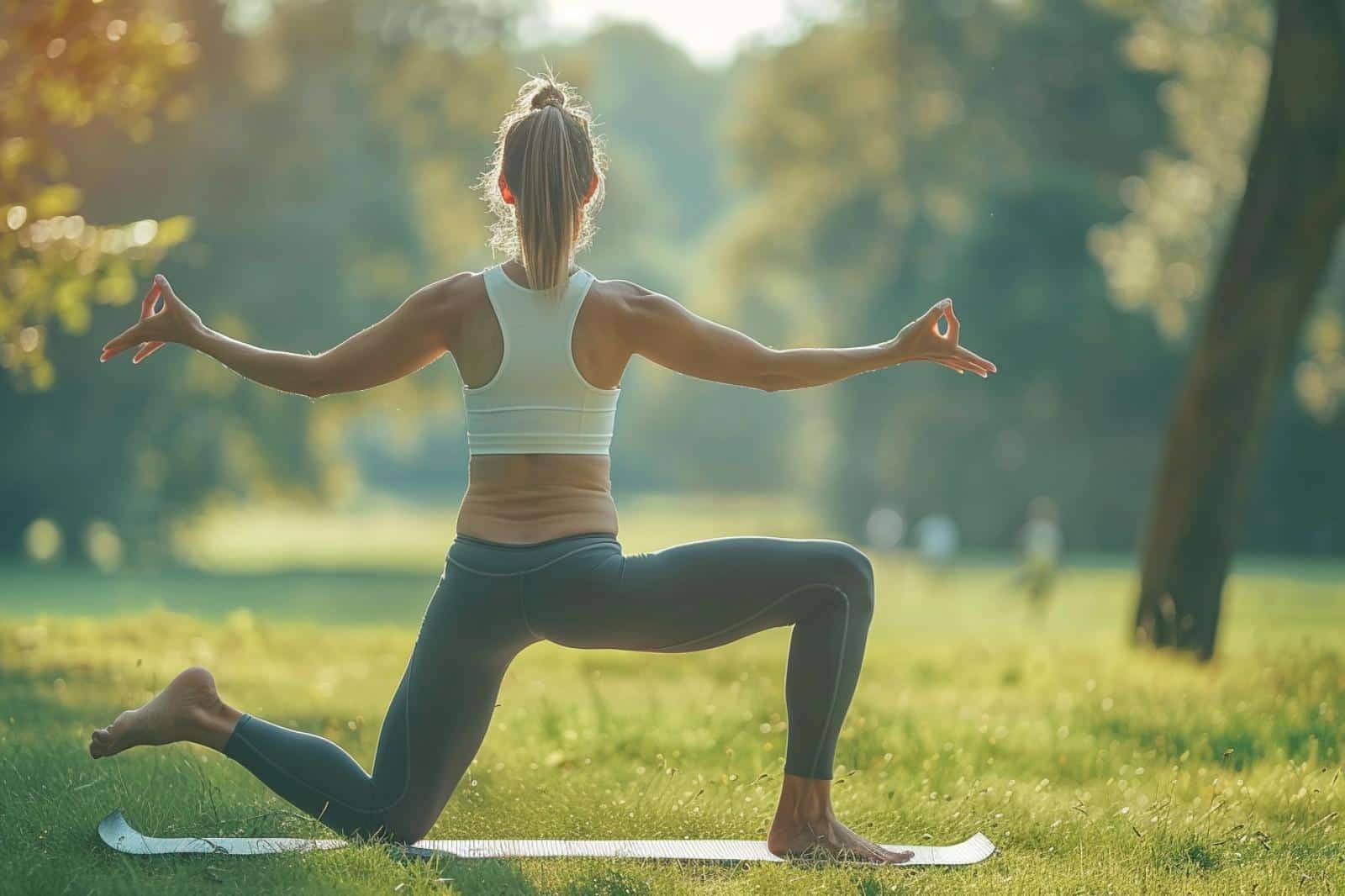How to Integrate Sport-Specific Yoga Poses for Injury Prevention in Runners?

Running is a popular form of exercise enjoyed by millions of people worldwide. However, the repetitive nature of this activity can sometimes lead to common overuse injuries. Incorporating yoga into your training regime can help mitigate this risk, providing a comprehensive method of strengthening and stretching key running muscles. Let’s look at how integrating sport-specific yoga poses can contribute to injury prevention in runners.
Understanding the Benefits of Yoga for Runners
Like running, yoga is a timeless practice that has been embraced by various cultures across centuries. But, what exactly makes it beneficial for runners?
En parallèle : What Are the Strategies for Enhancing Foot Speed and Agility in Field Hockey Players?
Yoga offers a plethora of advantages for runners. Beyond its traditional benefits of increased flexibility and improved balance, it also enables athletes to connect their mind and body, facilitating a better understanding of their physical limits. This connection helps to prevent injuries by promoting mindfulness during the running process.
Additionally, yoga can enhance runners’ performance by developing core strength, improving posture, and increasing lung capacity – all vital aspects of efficient running.
A découvrir également : What’s the Impact of Altitude Training on Oxygen Utilization in Endurance Athletes?
Choosing the Right Yoga Poses for Runners
Not all yoga poses are created equal, especially when it comes to runners. Certain poses are more advantageous for runners as they specifically target areas that are often strained during running.
Choosing the right poses can help in strengthening the lower body, improving flexibility in the hips, and enhancing stability. Key muscles and joints that need attention include the hips, hamstrings, quadriceps, and the lower back.
To get the maximum benefits, runners should focus on yoga poses that stretch and strengthen these areas. This will not only aid in injury prevention but also enhance overall running performance.
Incorporating Yoga into Your Running Routine
Integrating yoga into your running routine doesn’t have to be complicated. The key is to start slow and gradually increase the intensity and duration of your yoga sessions.
Begin with simple poses that are easy to do and focus on the areas most needed. As your body becomes accustomed to these poses, you can then incorporate more challenging poses into your routine.
Remember, the goal here is not to become a yoga expert but to use yoga as a tool to enhance your running and prevent injuries. So, listen to your body and adjust your yoga routine as necessary.
Practicing Yoga Poses for Injury Prevention
Let’s now delve into some specific yoga poses that are particularly beneficial for runners.
-
Downward Facing Dog: This pose stretches and strengthens the entire body, with emphasis on the hamstrings, calves, and spine. It also helps open up the chest and shoulders – areas that often tighten up during running.
-
Warrior I and II: These poses strengthen the legs, open up the hips, and improve balance. They are excellent for runners as they target the lower body, promote stability, and increase focus.
-
Low Lunge (Anjaneyasana): This pose stretches the hip flexors and quadriceps, which are often tight in runners. It also helps to improve balance and stability.
-
Pigeon Pose: This pose is one of the most effective for opening up the hips and loosening the hip flexors, an area that can often be tight in runners.
-
Legs-Up-The-Wall Pose: This restorative pose can aid recovery after a run by enabling the blood flow to return from the lower body back to the heart. It can also help to alleviate any swelling or soreness in the feet and legs.
Maintaining Consistency in Your Yoga Practice
Incorporating yoga into your running routine is not a one-time fix but a continuous process for injury prevention. Consistency in your yoga practice is key to harnessing its full benefits.
Set aside specific days and times for your yoga sessions and stick to this schedule as much as possible. This will not only create a habit but also ensure that your body gets the regular stretching and strengthening it needs to ward off potential running injuries.
Remember that while yoga is an excellent tool for injury prevention, it doesn’t replace other important aspects of running such as proper running technique, appropriate footwear, and adequate rest and recovery. Therefore, ensure that you are also paying attention to these areas to keep running injuries at bay.
Through consistent practice, not only can yoga aid in preventing injuries, but it can also help you become a more mindful and efficient runner. And who knows, you might even find that you enjoy your runs more with the added calm and flexibility that yoga brings!
Understanding the Role of Breath in Yoga for Runners
In yoga, breath plays a critical role. It’s not simply an element of the practice, but the very essence of it. For runners, understanding and harnessing the power of breath can be transformative.
Deep, controlled breathing, as practiced in yoga, can help to improve lung capacity and efficiency, which in turn can boost running endurance. Deep breathing techniques can also help to steady the heart rate during intense running sessions, thereby reducing fatigue.
Additionally, the focus on breath can cultivate mindfulness. By concentrating on each inhale and exhale, runners can develop an increased awareness of their bodies and their movements. This higher level of body consciousness can help to identify signs of strain or injury early on, allowing for timely intervention and injury prevention.
Furthermore, the rhythmic aspect of yoga breathing can have a calming effect on the mind. This mental calmness can help runners to better handle the challenges and pressures of competitive running.
Practicing yoga breathing techniques doesn’t have to be complex. Start with simple techniques such as the three-part breath, where you focus on filling the abdomen, rib cage, and upper chest with each inhale, then slowly emptying each part with each exhale. As you become more comfortable with this, you can explore more advanced techniques such as alternate nostril breathing or breath retention.
The Importance of Restorative Yoga for Runners
While yoga is often associated with active, dynamic poses, it also includes gentler, restorative poses that are particularly beneficial for runners.
Restorative yoga poses are designed to relax and restore the body. They often involve the use of props such as bolsters, blocks, and blankets to support the body in a comfortable position, allowing for deep relaxation and recovery.
For runners, restorative yoga can aid in recovery post-run by helping to reduce muscle soreness and tension. It can also help to improve flexibility over time, further aiding in injury prevention.
Poses such as Legs-Up-The-Wall Pose or Corpse Pose can be particularly beneficial. Legs-Up-The-Wall Pose, as mentioned earlier, can help to reduce swelling and soreness in the legs and feet. Corpse Pose, on the other hand, allows for complete relaxation and recovery. It’s often practiced at the end of a yoga session, but can also be used as a stand-alone pose for relaxation and recovery on rest days.
Remember, restorative yoga should be practiced with a focus on relaxation, not stretching. The goal here is not to push your body, but to allow it to relax and recover.
Conclusion: Embracing Yoga as a Runner
In conclusion, incorporating sport-specific yoga poses into your running routine can significantly aid in injury prevention. Understanding the benefits of yoga for runners, choosing the right poses, incorporating yoga into your routine, practicing specific poses, and maintaining consistency in your practice, are all key steps in this process.
Notably, understanding the role of breath in yoga and the importance of restorative poses can further enhance your running performance and injury prevention strategy.
While it may seem challenging at first, starting slow and gradually increasing the intensity and duration of your yoga sessions can make the process manageable and enjoyable.
Embrace yoga as a tool to not only enhance your running performance but also to connect with your body, cultivate mindfulness, and improve your overall health and wellbeing. Happy running and yoga practicing!
